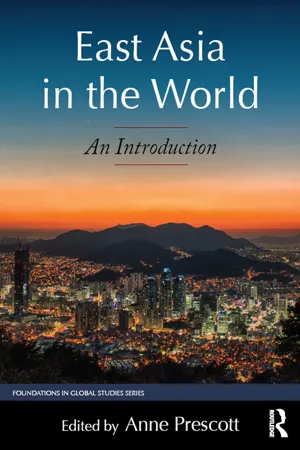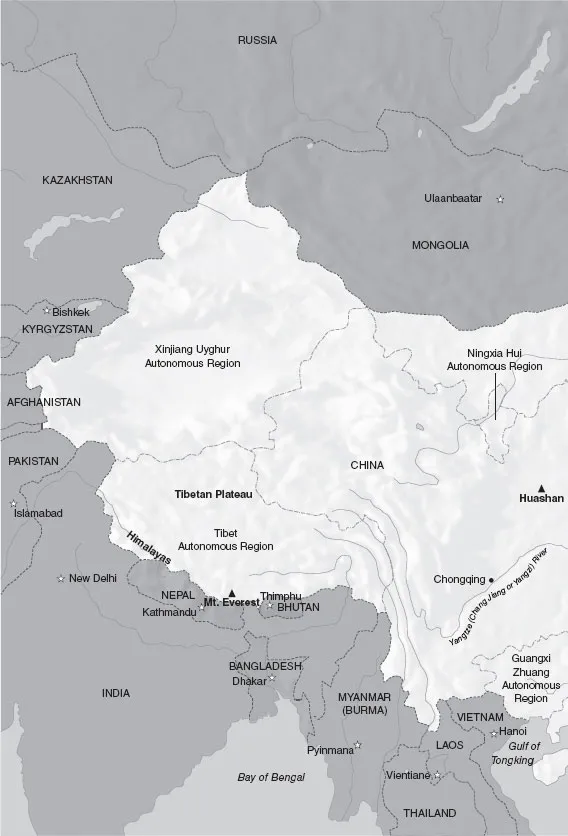![]()
PART ONE
Overview
![]()
1
Introducing East Asia
ANNE PRESCOTT
East Asia is geographically expansive, culturally diverse, economically vital, and the source of traditions both old and new. It is also often misunderstood. Indeed, the term “East Asia” conjures up many images: of Japanese cosplay (“costume play”—dressing up in costumes to represent a character, often from manga or anime), kung fu (gongfu), or kimchi (spicy Korean vegetables); of Kim Jong-un, Mao Zedong, or Ichiro Suzuki; and of the films of Miyazaki Hayao, the music of Psy, or the art of Ai Weiwei.
There is no single highway through the historical and cultural landscape of East Asia; each person approaches it from a different place on the map, and we can choose any number of roads to begin to learn about—and understand—this region in the western Pacific that is home to 20 percent of the world’s population. Once distanced from much of the rest of the world by geographical barriers and long journeys, today technology has helped bridge the gap and allows us to interact with the people of East Asia, leading us to discoveries about how they have become part of today’s global landscape.
This chapter briefly considers some of defining characteristics of the region as well as the geographical, historical, and cultural traits that distinguish each of the countries of East Asia. (See Table 1.1 for a statistical snapshot of East Asia.) It focuses on those characteristics critical to understanding the role these nations play in globalization, and on a number of the challenges they face, either individually or as a region. With this introduction, each reader will begin to discover the best route for traveling through the complexities of East Asia in today’s world.
Defining East Asia
The countries of China (including Taiwan), North Korea, South Korea, and Japan are grouped together under the umbrella of “East Asia,” based on their geographic proximity as well as historical and modern cultural and economic ties, particularly two prominent common cultural bonds originating in China. The first is Confucianism, an ethical and philosophical system that permeates deeply into East Asian societies. (See Chapter 12 for a discussion of Confucianism in East Asia today.) The second is the use of Chinese characters (called hanzi in Chinese) in their writing systems. Adopted centuries ago in Korea and Japan, the people in those countries continue to refer to this writing system as “Chinese characters” in their languages (kanji in Japanese, hanja in Korean). Examples of how the characters are used will be found in the chapter on languages. China, the Koreas, and Japan are also facing many of the same environmental, economic and cultural hurdles in the twenty-first century, some of which are the result of or exacerbated by an increasingly integrated global world.
East Asia: China (including Taiwan), Japan, North Korea and South Korea, its neighbors, and the major geographical features and cities cited in this introduction.
Based on these criteria, Vietnam may also be considered a part of the greater sphere of Chinese influence, and, as such, some scholars include Vietnam in East Asia. Although Confucianism continues to be important in Vietnamese culture, Chinese characters are no longer used in its written language, and many scholars and scholarly organizations classify Vietnam as a Southeast Asian country. Mongolia is geographically just to the north of China, but neither Confucianism nor the Chinese writing system have played a role in the culture and society of that region. As a result, Mongolia is usually grouped with other Inner Asian (sometimes referred to as Eurasian) countries such as Uzbekistan, Turkmenistan, Tajikistan, Kyrgyzstan, and Kazakhstan. Scholars of Inner Asia may also study the people in the Xinjiang, Inner Mongolia, and Tibet regions of China.
The Sinor Research Institute for Inner Asian Studies (http://www.indiana.edu/~srifias/) and the Inner Asian & Uralic National Resource Center (http://www.indiana.edu/~iaunrc/), both at Indiana University, are good resources for understanding the differences between East Asia and Inner Asia.
Geography and Climate
The climates in East Asia range from subarctic in the north to tropical in the south, and are influenced by continental winds from the northwest, monsoon winds from the southwest, and typhoons that crawl up the coasts of China, Korea, and Japan. Long rivers traverse the continent, while much shorter rivers flow from the mountains to the sea on the Korean Peninsula and in Japan. Desert lands spread out in northwestern China, and the high Tibetan plateau is known as the “roof of the world.” The Pacific basin is bordered by the Ring of Fire, a seismically active belt that spawns frequent earthquakes and volcanoes that affect East Asia. Mountains feature prominently in the history and culture of the region. Koreans consider Mount Paektu, on the border between China and Korea, to be the sacred place of their ancestral origin. Mount Fuji is one of the three sacred mountains in Japan, and in 2013 it was named a UNESCO World Heritage Site. The Himalayas, the tallest mountain range in the world, mark part of China’s western boundary, and the Five Great Mountains—Taishan, Huashan, Hengshan (in Hunan Province), Hengshan (in Shanxi Province) and Songshan—are important landmarks in China.
Table 1.1
A Statistical Snapshot of East Asian Countries
Source: Compiled from the CIA World Factbook, https://www.cia.gov/library/publications/the-world-factbook/wfbExt/region_eas.html, accessed May 16, 2014.
China
Historically, “China” referred to a collection of kingdoms and empires, commonly called dynasties. The area under dynastic rule changed over time as lands were conquered or lost in wars. Through much of history, the Chinese believed in the Mandate of Heaven, the idea that heaven gives the emperor (usually a male) the right to rule based on his ability to govern rather than his social status. Using this reasoning, even a commoner or a foreigner could be accepted as the ruler. Poverty and disaster were seen as signs from heaven that the ruling emperor was unjust and should be replaced.
Chinese Dynasties and Key Events
• Xia, ca. 2100–1600 BCE.
• Shang, ca. 1600–1050 BCE. Oldest written history dates from this dynasty.
• Zhou, ca. 1046–256 BCE. Longest-lasting dynasty in Chinese history.
• Qin, 221–206 BCE. Capital at Chang’an (Xi’an); created a unified state by imposing a centralized government; Qin emperor died in 210 and was buried with Terracotta Warriors.
• Han, 206 BCE–220 CE. Confucianism officially established as the basis for the Chinese state; the name of the dominant ethnic group in China, the Han, comes from the name of this dynasty, as does the name of the Chinese writing system, hanzi (literally “Chinese writing”). Silk Road began.
• Six Dynasties Period, 220–589 CE. Period of instability following the fall of the Han; Buddhism introduced to China.
• Sui, 581–618 CE. Reunification of China.
• Tang, 618–906 CE. Golden age of Chinese civilization. Chang’an (presently Xi’an) was the capital; at the eastern end of the Silk Road, it was the most populous city in the world at that time. The Tang Dynasty had great cultural influence on Korea, Japan, and Vietnam.
• Five Dynasties Period, 907–960 CE.
• Song, 960–1279 CE. Great economic and social changes occurred during this period.
• Yuan, 1279–1368 CE. Established by the Mongols under Kublai Khan; the Mongols reigned from Beijing over most of what we know as China today.
• Ming, 1368–1644 CE. Han reestablished rule.
• Qing, 1644–1912 CE. Manchus reigned from Beijing.
Source: Asia for Educators website, http://afe.easia.columbia.edu/timelines/china_timeline.htm.
A fun way to memorize the sequence of the Chinese dynasties is to sing them, as is shown in a YouTube video (http://www.youtube.com/watch?v=xJis9TSw1rE) sponsored by ChinaX, part of Harvard’s edX online learning offerings.
Under pressure from reformers hoping for modernization and a republican-style government, the last Manchu emperor abdicated in 1912, and the Qing Dynasty ended. During the first half of the twentieth century, various forces struggled to establish the modern state of China, leading up to the Chinese Civil War, which ended in 1949 with the exile of the Nationalists on the offshore island of Taiwan and the Communists in control of the mainland. Today China can refer to the People’s Republic of China (PRC), or mainland China, and the Republic of China (ROC) on Taiwan. Since 1949 both governments, separated by the narrow Taiwan Strait, have claimed to be the official representatives of the Chinese people. The United Nations acknowledged the PRC as the lawful representative of China in 1971. The United States recognized the ROC as the official representative of the Chinese people until 1979, at which time it recognized the PRC as the legitimate representative.
The People’s Republic of China (PRC, or Mainland China)
The People’s Republic of China is the fourth-largest country (in area) in the world (after Russia, Canada, and the United States), and with an estimated 1.35 billion people, it has the world’s largest population (followed closely by India, with the United States a distant third). The population is primarily concentrated on the eastern coast, and with the exception of a few regional cities, the western and central sections of the country are relatively sparsely inhabited. The major urban areas of the country include the capital, Beijing, in the northeast; Shanghai, in the east; Chongqing, the former provisional capital of Chiang Kai-shek’s government during World War II, in the southwest; and Shenzhen and Guangzhou, two important cities on the Pearl River Delta in the south.
The official name of the country today is Zhonghua Renmin Gongheguo (People’s Republic of China), but the Chinese usually refer to their country as Zhongguo, which means “Middle Kingdom.” Zhongguo has been used as the name of a collection of united provinces in the central plain for more than 2,500 years, and it reflects the Chinese idea that it resides at the center of the world. Given this name, it should come as no surprise that China shares borders with 14 countries.
China is not a homogenous nation. Han Chinese make up 91.6 percent of the population, with the remaining 8.4 percent, or nearly 115 million people, belonging to one of 55 ethnic minority groups recognized by the Chinese government (CIA World Factbook). These include Koreans, who live primarily in the region near the border with North Korea; Tibetans; Manchus; Mongols; and Uyghurs (also spelled Uighurs or Uygurs). Although the official language is Mandarin Chinese, other languages and regional dialects are spoken, and several autonomous regions have additional official languages. Regardless of the dialect—Cantonese or Mandarin, for example—the written language is the same. It is therefore not unusual in major cities to see two Chinese people who speak different dialects communicating with each other by writing words down. Minority issues, including those relating to domestic migrants, are thus very much a part of the reality of local, as well as global, exchanges and ...





